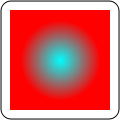- Color gradient
-
In computer graphics, a color gradient (sometimes called a color ramp or color progression) specifies a range of position-dependent colors, usually used to fill a region.[1] For example, many window managers allow the screen background to be specified as a gradient. The colors produced by a gradient vary continuously with position, producing smooth color transitions.
Contents
Linear gradients
A linear color gradient is specified by two points, and a color at each point. The colors along the line through those points are calculated using linear interpolation, then extended perpendicular to that line. In digital imaging systems, colors are typically interpolated in an RGB color space, often using gamma compressed RGB color values, as opposed to linear.
Circular gradients
A circular gradient is specified as a circle that has one color and a focus (the center of the circle) that has another. Colors are calculated by linear interpolation based on distance from the focus.
References
- ^ Eisenberg, J. David (2002). SVG Essentials. O'Reilly Media. p. 107. ISBN 0596002238.
See also
- Image gradient
- Color banding
- Posterization

This graphics software-related article is a stub. You can help Wikipedia by expanding it.


